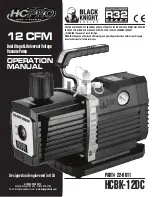
5
7 SERIES 700A11 INSTALLATION MANUAL
WARNING: Before performing service or
maintenance operations on a system, turn off main
power switches to the indoor unit. If applicable,
turn off the accessory heater power switch.
Electrical shock could cause personal injury.
Installing and servicing heating and air conditioning
equipment can be hazardous due to system pressure and
electrical components. Only trained and qualified service
personnel should install, repair or service heating and air
conditioning equipment. Untrained personnel can perform
the basic maintenance functions of cleaning coils and
cleaning and replacing filters. All other operations should
be performed by trained service personnel. When working
on heating and air conditioning equipment, observe
precautions in the literature, tags and labels attached to the
unit and other safety precautions that may apply.
Follow all safety codes. Wear safety glasses and work
gloves. Use a quenching cloth for brazing operations and
have a fire extinguisher available.
Moving and Storage
Move units in the normal “up” orientation. Horizontal units
may be moved and stored per the information on the
packaging. Do not stack more than three units in total
height. Vertical units may be stored one upon another to
a maximum height of two units. Do not attempt to move
units while stacked. When the equipment is received, all
items should be carefully checked against the bill of lading
to be sure all crates and cartons have been received.
Examine units for shipping damage, removing the units
from the packaging if necessary. Units in question should
also be internally inspected. If any damage is noted, the
carrier should make the proper notation on the delivery
receipt, acknowledging the damage.
Unit Location
Locate the unit in an indoor area, minimum ambient of
45°F and maximum ambient of 100°F, that allows for easy
removal of the filter and access panels. Attic installations
are not approved and could result in loss of warranty.
Installation is not recommended in areas with excessive dirt
and debris as this may be drawn into the VS drive causing
overheating of the VS drive. Location should have enough
space for service personnel to perform maintenance or
repair. Provide sufficient room to make water, electrical
and duct connection(s). If the unit is located in a confined
space, such as a closet, provisions must be made for return
air to freely enter the space by means of a louvered door,
etc. Any access panel screws that would be difficult to
remove after the unit is installed should be removed prior
to setting the unit. On horizontal units, allow adequate
room below the unit for a condensate drain trap and do not
locate the unit above supply piping.
Care should be taken
Safety Considerations
General Installation Information
Figure 1: Vertical Unit Mounting
2 in. Extruded
Polystyrene
when units are located in unconditioned spaces to prevent
damage from frozen water lines and excessive heat that
could damage electrical components.
Filter Rack Conversion
A 2 in. MERV 11 filter is shipped with the heat pump. To
field convert the filter rack to use 1 in. filters, simply insert
the provided plastic push pins into the holes located in the
filter rack. There are holes on the top and bottom of the
rack, underneath the instruction labels, for field conversion
to 1 in. filters.
Installing Vertical Units
Prior to setting the unit in place, remove and discard the
compressor hold down shipping bolt located at the front of
the compressor mounting bracket.
Vertical units are available in left or right air return
configurations. Top and rear air discharge vertical units
should be mounted level on a vibration absorbing pad
slightly larger than the base to provide isolation between
the unit and the floor. It is not necessary to anchor the unit
to the floor (see below).
Bottomflow units should be mounted level and sealed well
to floor to prevent air leakage. Bottomflow units require
the supply air opening to be cut at least 1/2 in. larger than
the unit’s air outlet. Protect the edges of combustible
flooring with sheet metal over-wrap or other non-
combustible material.






































